- What Is Python? An Introduction
- What Is The History Of Python?
- Key Features Of The Python Programming Language
- Who Uses Python?
- Basic Characteristics Of Python Programming Syntax
- Why Should You Learn Python?
- Applications Of Python Language
- Advantages And Disadvantages Of Python
- Some Useful Python Tips & Tricks For Efficient Programming
- Python 2 Vs. Python 3: Which Should You Learn?
- Python Libraries
- Conclusion
- Frequently Asked Questions
- It's Python Basics Quiz Time!
- What is Python & its Brief History
- Key Features of Python Programming Language
- Applications of Python Language
- Practical Python Code Examples
- About Python IDLE
- Comparative Features of Python, Java, & C++
- Conclusion
- Frequently Asked Questions
- Take A Quiz To Rehash Python's Features!
- What Is Python IDLE?
- What Is Python Shell & Its Uses?
- Primary Features Of Python IDLE
- How To Use Python IDLE Shell? Setting Up Your Python Environment
- How To Work With Files In Python IDLE?
- How To Execute A File In Python IDLE?
- Improving Workflow In Python IDLE Software
- Debugging In Python IDLE
- Customizing Python IDLE
- Code Examples
- Conclusion
- Frequently Asked Questions (FAQs)
- How Well Do You Know IDLE? Take A Quiz!
- What Is A Variable In Python?
- Creating And Declaring Python Variables
- Rules For Naming Python Variables
- How To Print Python Variables?
- How To Delete A Python Variable?
- Various Methods Of Variables Assignment In Python
- Python Variable Types
- Python Variable Scope
- Concatenating Python Variables
- Object Identity & Object References Of Python Variables
- Reserved Words/ Keywords & Python Variable Names
- Conclusion
- Frequently Asked Questions
- Rehash Python Variables Basics With A Quiz!
- What Is A String In Python?
- Creating String In Python
- How To Create Multiline Python Strings?
- Reassigning Python Strings
- Accessing Characters Of Python Strings
- How To Update Or Delete A Python String?
- Reversing A Python String
- Formatting Python Strings
- Concatenation & Comparison Of Python Strings
- Python String Operators
- Python String Functions
- Escape Sequences In Python Strings
- Conclusion
- Frequently Asked Questions
- Rehash Python Strings Basics With A Quiz!
- What Is Python Namespace?
- Lifetime Of Python Namespace
- Types Of Python Namespace
- The Built-In Namespace In Python
- The Global Namespace In Python
- The Local Namespace In Python
- The Enclosing Namespace In Python
- Variable Scope & Namespace In Python
- Python Namespace Dictionaries
- Changing Variables Out Of Their Scope & Python Namespace
- Best Practices Of Python Namespace
- Conclusion
- Frequently Asked Questions
- Test Your Knowledge Of Python Namespaces!
- What Are Logical Operators In Python?
- The AND Python Logical Operator
- The OR Python Logical Operator
- The NOT Python Logical Operator
- Short-Circuiting Evaluation Of Python Logical Operators
- Precedence of Logical Operators In Python
- How Does Python Calculate Truth Value?
- Final Note On How AND & OR Python Logical Operators Work
- Conclusion
- Frequently Asked Questions
- Python Logical Operators Quiz– Test Your Knowledge!
- What Are Bitwise Operators In Python?
- List Of Python Bitwise Operators
- AND Python Bitwise Operator
- OR Python Bitwise Operator
- NOT Python Bitwise Operator
- XOR Python Bitwise Operator
- Right Shift Python Bitwise Operator
- Left Shift Python Bitwise Operator
- Python Bitwise Operations On Negative Integers
- The Binary Number System
- Application of Python Bitwise Operators
- Python Bitwise Operator Overloading
- Conclusion
- Frequently Asked Questions
- Test Your Knowledge Of Python Bitwise Operators!
- What Is The Print() Function In Python?
- How Does The print() Function Work In Python?
- How To Print Single & Multi-line Strings In Python?
- How To Print Built-in Data Types In Python?
- Print() Function In Python For Values Stored In Variables
- Print() Function In Python With sep Parameter
- Print() Function In Python With end Parameter
- Print() Function In Python With flush Parameter
- Print() Function In Python With file Parameter
- How To Remove Newline From print() Function In Python?
- Use Cases Of The print() Function In Python
- Understanding Print Statement In Python 2 Vs. Python 3
- Conclusion
- Frequently Asked Questions
- Know The print() Function In Python? Take A Quiz!
- Working Of Normal Print() Function
- The New Line Character In Python
- How To Print Without Newline In Python | Using The End Parameter
- How To Print Without Newline In Python 2.x? | Using Comma Operator
- How To Print Without Newline In Python 3.x?
- How To Print Without Newline In Python With Module Sys
- The Star Pattern(*) | How To Print Without Newline & Space In Python
- How To Print A List Without Newline In Python?
- How To Remove New Lines In Python?
- Conclusion
- Frequently Asked Questions
- Think You Can Print Without a Newline in Python? Prove It!
- What Is A Python For Loop?
- How Does Python For Loop Work?
- When & Why To Use Python For Loops?
- Python For Loop Examples
- What Is Rrange() Function In Python?
- Nested For Loops In Python
- Python For Loop With Continue & Break Statements
- Python For Loop With Pass Statement
- Else Statement In Python For Loop
- Conclusion
- Frequently Asked Questions
- Think You Know Python's For Loop? Prove It!
- What Is Python While Loop?
- How Does The Python While Loop Work?
- How To Use Python While Loops For Iterations?
- Control Statements In Python While Loop With Examples
- Python While Loop With Python List
- Infinite Python While Loop in Python
- Python While Loop Multiple Conditions
- Nested Python While Loops
- Conclusion
- Frequently Asked Questions
- Mastered Python While Loop? Let’s Find Out!
- What Are Conditional If-Else Statements In Python?
- Types Of If-Else Statements In Python
- If Statement In Python
- If-Else Statement In Python
- Nested If-Else Statement In Python
- Elif Statement In Python
- Ladder If-Elif-Else Statement In Python
- Short Hand If-Statement In Python
- Short Hand If-Else Statement In Python
- Operators & If-Esle Statement In Python
- Other Statements With If-Else In Python
- Conclusion
- Frequently Asked Questions
- Quick If-Else Statement Quiz– Let’s Go!
- What Is Control Structure In Python?
- Types Of Control Structures In Python
- Sequential Control Structures In Python
- Decision-Making Control Structures In Python
- Repetition Control Structures In Python
- Benefits Of Using Control Structures In Python
- Conclusion
- Frequently Asked Questions
- Control Structures in Python – Are You the Master? Take A Quiz!
- What Are Python Libraries?
- How Do Python Libraries Work?
- Standard Python Libraries (With List)
- Important Python Libraries For Data Science
- Important Python Libraries For Machine & Deep Learning
- Other Important Python Libraries You Must Know
- Working With Third-Party Python Libraries
- Troubleshooting Common Issues For Python Libraries
- Python Libraries In Larger Projects
- Importance Of Python Libraries
- Conclusion
- Frequently Asked Questions
- Quick Quiz On Python Libraries – Let’s Go!
- What Are Python Functions?
- How To Create/ Define Functions In Python?
- How To Call A Python Function?
- Types Of Python Functions Based On Parameters & Return Statement
- Rules & Best Practices For Naming Python Functions
- Basic Types of Python Functions
- The Return Statement In Python Functions
- Types Of Arguments In Python Functions
- Docstring In Python Functions
- Passing Parameters In Python Functions
- Python Function Variables | Scope & Lifetime
- Advantages Of Using Python Functions
- Recursive Python Function
- Anonymous/ Lambda Function In Python
- Nested Functions In Python
- Conclusion
- Frequently Asked Questions
- Python Functions – Test Your Knowledge With A Quiz!
- What Are Python Built-In Functions?
- Mathematical Python Built-In Functions
- Python Built-In Functions For Strings
- Input/ Output Built-In Functions In Python
- List & Tuple Python Built-In Functions
- File Handling Python Built-In Functions
- Python Built-In Functions For Dictionary
- Type Conversion Python Built-In Functions
- Basic Python Built-In Functions
- List Of Python Built-In Functions (Alphabetical)
- Conclusion
- Frequently Asked Questions
- Think You Know Python Built-in Functions? Prove It!
- What Is A round() Function In Python?
- How Does Python round() Function Work?
- Python round() Function If The Second Parameter Is Missing
- Python round() Function If The Second Parameter Is Present
- Python round() Function With Negative Integers
- Python round() Function With Math Library
- Python round() Function With Numpy Module
- Round Up And Round Down Numbers In Python
- Truncation Vs Rounding In Python
- Practical Applications Of Python round() Function
- Conclusion
- Frequently Asked Questions
- Revisit Python’s round() Function – Take The Quiz!
- What Is Python pow() Function?
- Python pow() Function Example
- Python pow() Function With Modulus (Three Parameters)
- Python pow() Function With Complex Numbers
- Python pow() Function With Floating-Point Arguments And Modulus
- Python pow() Function Implementation Cases
- Difference Between Inbuilt-pow() And math.pow() Function
- Conclusion
- Frequently Asked Questions
- Test Your Knowledge Of Python’s pow() Function!
- Python max() Function With Objects
- Examples Of Python max() Function With Objects
- Python max() Function With Iterable
- Examples Of Python max() Function With Iterables
- Potential Errors With The Python max() Function
- Python max() Function Vs. Python min() Functions
- Conclusion
- Frequently Asked Questions
- Think You Know Python max() Function? Take A Quiz!
- What Are Strings In Python?
- What Are Python String Methods?
- List Of Python String Methods For Manipulating Case
- List Of Python String Methods For Searching & Finding
- List Of Python String Methods For Modifying & Transforming
- List Of Python String Methods For Checking Conditions
- List Of Python String Methods For Encoding & Decoding
- List Of Python String Methods For Stripping & Trimming
- List Of Python String Methods For Formatting
- Miscellaneous Python String Methods
- List Of Other Python String Operations
- Conclusion
- Frequently Asked Questions
- Mastered Python String Methods? Take A Quiz!
- What Is Python String?
- The Need For Python String Replacement
- The Python String replace() Method
- Multiple Replacements With Python String.replace() Method
- Replace A Character In String Using For Loop In Python
- Python String Replacement Using Slicing Method
- Replace A Character At a Given Position In Python String
- Replace Multiple Substrings With The Same String In Python
- Python String Replacement Using Regex Pattern
- Python String Replacement Using List Comprehension & Join() Method
- Python String Replacement Using Callback With re.sub() Method
- Python String Replacement With re.subn() Method
- Conclusion
- Frequently Asked Questions
- Know How To Replace Python Strings? Prove It!
- What Is String Slicing In Python?
- How Indexing & String Slicing Works In Python
- Extracting All Characters Using String Slicing In Python
- Extracting Characters Before & After Specific Position Using String Slicing In Python
- Extracting Characters Between Two Intervals Using String Slicing In Python
- Extracting Characters At Specific Intervals (Step) Using String Slicing In Python
- Negative Indexing & String Slicing In Python
- Handling Out-of-Bounds Indices In String Slicing In Python
- The slice() Method For String Slicing In Python
- Common Pitfalls Of String Slicing In Python
- Real-World Applications Of String Slicing
- Conclusion
- Frequently Asked Questions
- Quick Python String Slicing Quiz– Let’s Go!
- Introduction To Python List
- How To Create A Python List?
- How To Access Elements Of Python List?
- Accessing Multiple Elements From A Python List (Slicing)
- Access List Elements From Nested Python Lists
- How To Change Elements In Python Lists?
- How To Add Elements To Python Lists?
- Delete/ Remove Elements From Python Lists
- How To Create Copies Of Python Lists?
- Repeating Python Lists
- Ways To Iterate Over Python Lists
- How To Reverse A Python List?
- How To Sort Items Of Python Lists?
- Built-in Functions For Operations On Python Lists
- Conclusion
- Frequently Asked Questions
- Revisit Python Lists Basics With A Quick Quiz!
- What Is List Comprehension In Python?
- Incorporating Conditional Statements With List Comprehension In Python
- List Comprehension In Python With range()
- Filtering Lists Effectively With List Comprehension In Python
- Nested Loops With List Comprehension In Python
- Flattening Nested Lists With List Comprehension In Python
- Handling Exceptions In List Comprehension In Python
- Common Use Cases For List Comprehensions
- Advantages & Disadvantages Of List Comprehension In Python
- Best Practices For Using List Comprehension In Python
- Performance Considerations For List Comprehension In Python
- For Loops & List Comprehension In Python: A Comparison
- Difference Between Generator Expression & List Comprehension In Python
- Conclusion
- Frequently Asked Questions
- Rehash Python List Comprehension Basics With A Quiz!
- What Is A List In Python?
- How To Find Length Of List In Python?
- For Loop To Get Python List Length (Naive Approach)
- The len() Function To Get Length Of List In Python
- The length_hint() Function To Find Length Of List In Python
- The sum() Function To Find The Length Of List In Python
- The enumerate() Function To Find Python List Length
- The Counter Class From collections To Find Python List Length
- The List Comprehension To Find Python List Length
- Find The Length Of List In Python Using Recursion
- Comparison Between Ways To Find Python List Length
- Conclusion
- Frequently Asked Questions
- Know How To Get Python List Length? Prove it!
- List of Methods To Reverse A Python List
- Python Reverse List Using reverse() Method
- Python Reverse List Using the Slice Operator ([::-1])
- Python Reverse List By Swapping Elements
- Python Reverse List Using The reversed() Function
- Python Reverse List Using A for Loop
- Python Reverse List Using While Loop
- Python Reverse List Using List Comprehension
- Python Reverse List Using List Indexing
- Python Reverse List Using The range() Function
- Python Reverse List Using NumPy
- Comparison Of Ways To Reverse A Python List
- Conclusion
- Frequently Asked Questions
- Time To Test Your Python List Reversal Skills!
- What Is Indexing In Python?
- The Python List index() Function
- How To Use Python List index() To Find Index Of A List Element
- The Python List index() Method With Single Parameter (Start)
- The Python List index() Method With Start & Stop Parameters
- What Happens When We Use Python List index() For An Element That Doesn't Exist
- Python List index() With Nested Lists
- Fixing IndexError Using The Python List index() Method
- Python List index() With Enumerate()
- Real-world Examples Of Python List index() Method
- Difference Between find() And index() Method In Python
- Conclusion
- Frequently Asked Questions
- Think You Know Python List Indexing? Take A Quiz!
- How To Remove Elements From List In Python?
- The remove() Method To Remove Element From Python List
- The pop() Method To Remove Element From List In Python
- The del Keyword To Remove Element From List In Python
- The clear() Method To Remove Elements From Python List
- List Comprehensions To Conditionally Remove Element From List In Python
- Key Considerations For Removing Elements From Python Lists
- Why We Need to Remove Elements From Python List
- Performance Comparison Of Methods To Remove Element From List In Python
- Conclusion
- Frequently Asked Questions
- Quiz– Prove You Know How To Remove Item From Python Lists!
- How To Remove Duplicates From A List In Python?
- The set() Function To Remove Duplicates From Python List
- Remove Duplicates From Python List Using For Loop
- Using List Comprehension Remove Duplicates From Python List
- Remove Duplicates From Python List Using enumerate() With List Comprehension
- Dictionary & fromkeys() Method To Remove Duplicates From Python List
- Remove Duplicates From Python List Using in, not in Operators
- Remove Duplicates From Python List Using collections.OrderedDict.fromkeys()
- Remove Duplicates From Python List Using Counter with freq.dist() Method
- The del Keyword Remove Duplicates From Python List
- Remove Duplicates From Python List Using DataFrame
- Remove Duplicates From Python List Using pd.unique and np.unipue
- Remove Duplicates From Python List Using reduce() function
- Comparative Analysis Of Ways To Remove Duplicates From Python List
- Conclusion
- Frequently Asked Questions
- Think You Know How to Remove Duplicates? Take A Quiz!
- What Is Python List & How To Access Elements?
- What Is IndexError: List Index Out Of Range & Its Causes In Python?
- Understanding Indexing Behavior In Python Lists
- How to Prevent/ Fix IndexError: List Index Out Of Range In Python
- Handling IndexError Gracefully Using Try-Except
- Debugging Tips For IndexError: List Index Out Of Range Python
- Conclusion
- Frequently Asked Questions
- Avoiding ‘List Index Out of Range’ Errors? Take A Quiz!
- What Is the Python sort() List Method?
- Sorting In Ascending Order Using The Python sort() List Method
- How To Sort Items In Descending Order Using Python sort() List Method
- Custom Sorting Using The Key Parameter Of Python sort() List Method
- Examples Of Python sort() List Method
- What Is The sorted() List Method In Python
- Differences Between sorted() And sort() List Methods In Python
- When To Use sorted() & When To Use sort() List Method In Python
- Conclusion
- Frequently Asked Questions
- Take A Quick Python's sort() Quiz!
- What Is A List In Python?
- What Is A String In Python?
- Why Convert Python List To String?
- How To Convert List To String In Python?
- The join() Method To Convert Python List To String
- Convert Python List To String Through Iteration
- Convert Python List To String With List Comprehension
- The map() Function To Convert Python List To String
- Convert Python List to String Using format() Function
- Convert Python List To String Using Recursion
- Enumeration Function To Convert Python List To String
- Convert Python List To String Using Operator Module
- Python Program To Convert String To List
- Conclusion
- Frequently Asked Questions
- Convert Lists To Strings Like A Pro! Take A Quiz
- What Is Inheritance In Python?
- Python Inheritance Syntax
- Parent Class In Python Inheritance
- Child Class In Python Inheritance
- The __init__() Method In Python Inheritance
- The super() Function In Python Inheritance
- Method Overriding In Python Inheritance
- Types Of Inheritance In Python
- Special Functions In Python Inheritance
- Advantages & Disadvantages Of Inheritance In Python
- Common Use Cases For Inheritance In Python
- Best Practices for Implementing Inheritance in Python
- Avoiding Common Pitfalls in Python Inheritance
- Conclusion
- Frequently Asked Questions
- 💡 Python Inheritance Quiz – Are You Ready?
- What Is The Python List append() Method?
- Adding Elements To A Python List Using append()
- Populate A Python List Using append()
- Adding Different Data Types To Python List Using append()
- Adding A List To Python List Using append()
- Nested Lists With Python List append() Method
- Practical Use Cases Of Python List append() Method
- How append() Method Affects List Performance
- Avoiding Common Mistakes When Using Python List append()
- Comparing extend() With append() Python List Method
- Conclusion
- Frequently Asked Questions
- 🧠 Think You Know Python List append()? Take A Quiz!
- What Is A Linked List In Python?
- Types Of Linked Lists In Python
- How To Create A Linked List In Python
- How To Traverse A Linked List In Python & Retrieve Elements
- Inserting Elements In A Linked List In Python
- Deleting Elements From A Linked List In Python
- Update A Node Of Linked List In Python
- Reversing A Linked List In Python
- Calculating Length Of A Linked List In Python
- Comparing Arrays And Linked Lists In Python
- Advantages & Disadvantages Of Linked List In Python
- When To Use Linked Lists Over Other Data Structures
- Practical Applications Of Linked Lists In Python
- Conclusion
- Frequently Asked Questions
- 🔗 Linked List Logic: Can You Ace This Quiz?
- What Is Extend In Python?
- Extend In Python With List
- Extend In Python With String
- Extend In Python With Tuple
- Extend In Python With Set
- Extend In Python With Dictionary
- Other Methods To Extend A List In Python
- Difference Between append() and extend() In Python
- Conclusion
- Frequently Asked Questions
- Think You Know extend() In Python? Prove It!
- What Is Recursion In Python?
- Key Components Of Recursive Functions In Python
- Implementing Recursion In Python
- Recursion Vs. Iteration In Python
- Tail Recursion In Python
- Infinite Recursion In Python
- Advantages Of Recursion In Python
- Disadvantages Of Recursion In Python
- Best Practices For Using Recursion In Python
- Conclusion
- Frequently Asked Questions
- Recursive Thinking In Python: Test Your Skills!
- What Is Type Conversion In Python?
- Types Of Type Conversion In Python
- Implicit Type Conversion In Python
- Explicit Type Conversion In Python
- Functions Used For Explicit Data Type Conversion In Python
- Important Type Conversion Tips In Python
- Benefits Of Type Conversion In Python
- Conclusion
- Frequently Asked Questions
- Think You Know Type Conversion? Take A Quiz!
- What Is Scope In Python?
- Local Scope In Python
- Global Scope In Python
- Nonlocal (Enclosing) Scope In Python
- Built-In Scope In Python
- The LEGB Rule For Python Scope
- Python Scope And Variable Lifetime
- Best Practices For Managing Python Scope
- Conclusion
- Frequently Asked Questions
- Think You Know Python Scope? Test Yourself!
- Understanding The Continue Statement In Python
- How Does Continue Statement Work In Python?
- Python Continue Statement With For Loops
- Python Continue Statement With While Loops
- Python Continue Statement With Nested Loops
- Python Continue With If-Else Statement
- Difference Between Pass and Continue Statement In Python
- Practical Applications Of Continue Statement In Python
- Conclusion
- Frequently Asked Questions
- Python 'continue' Statement Quiz: Can You Ace It?
- What Are Control Statements In Python?
- Types Of Control Statements In Python
- Conditional Control Statements In Python
- Loop Control Statements In Python
- Control Flow Altering Statements In Python
- Exception Handling Control Statements In Python
- Conclusion
- Frequently Asked Questions
- Mastering Control Statements In Python – Take the Quiz!
- Difference Between Mutable And Immutable Data Types in Python
- What Is Mutable Data Type In Python?
- Types Of Mutable Data Types In Python
- What Are Immutable Data Types In Python?
- Types Of Immutable Data Types In Python
- Key Similarities Between Mutable And Immutable Data Types In Python
- When To Use Mutable Vs Immutable In Python?
- Conclusion
- Frequently Asked Questions
- Quiz Time: Mutable vs. Immutable In Python!
- What Is A List?
- What Is A Tuple?
- Difference Between List And Tuple In Python (Comparison Table)
- Syntax Difference Between List And Tuple In Python
- Mutability Difference Between List And Tuple In Python
- Other Difference Between List And Tuple In Python
- List Vs. Tuple In Python | Methods
- When To Use Tuples Over Lists?
- Key Similarities Between Tuples And Lists In Python
- Conclusion
- Frequently Asked Questions
- 🧐 Lists vs. Tuples Quiz: Test Your Python Knowledge!
- Introduction to Python
- Downloading & Installing Python, IDLE, Tkinter, NumPy & PyGame
- Creating A New Python Project
- How To Write Python Hello World Program In Python?
- Way To Write The Hello, World! Program In Python
- The Hello, World! Program In Python Using Class
- The Hello, World! Program In Python Using Function
- Print Hello World 5 Times Using A For Loop
- Conclusion
- Frequently Asked Questions
- 👋 Python's 'Hello, World!'—How Well Do You Know It?
- Algorithm Of Python Program To Add To Numbers
- Standard Program To Add Two Numbers In Python
- Python Program To Add Two Numbers With User-defined Input
- The add() Method In Python Program To Add Two Numbers
- Python Program To Add Two Numbers Using Lambda
- Python Program To Add Two Numbers Using Function
- Python Program To Add Two Numbers Using Recursion
- Python Program To Add Two Numbers Using Class
- How To Add Multiple Numbers In Python?
- Add Multiple Numbers In Python With User Input
- Time Complexities Of Python Programs To Add Two Numbers
- Conclusion
- Frequently Asked Questions
- 💡 Quiz Time: Python Addition Basics!
- Swapping in Python
- Swapping Two Variables Using A Temporary Variable
- Swapping Two Variables Using The Comma Operator In Python
- Swapping Two Variables Using The Arithmetic Operators (+,-)
- Swapping Two Variables Using The Arithmetic Operators (*,/)
- Swapping Two Variables Using The XOR(^) Operator
- Swapping Two Variables Using Bitwise Addition and Subtraction
- Swap Variables In A List
- Conclusion
- Frequently Asked Questions (FAQs)
- Quiz To Test Your Variable Swapping Knowledge
- What Is A Quadratic Equation? How To Solve It?
- How To Write A Python Program To Solve Quadratic Equations?
- Python Program To Solve Quadratic Equations Directly Using The Formula
- Python Program To Solve Quadratic Equations Using The Complex Math Module
- Python Program To Solve Quadratic Equations Using Functions
- Python Program To Solve Quadratic Equations & Find Number Of Solutions
- Python Program To Plot Quadratic Functions
- Conclusion
- Frequently Asked Questions
- Quadratic Equations In Python Quiz: Test Your Knowledge!
- What Is Decimal Number System?
- What Is Binary Number System?
- What Is Octal Number System?
- What Is Hexadecimal Number System?
- Python Program to Convert Decimal to Binary, Octal, And Hexadecimal Using Built-In Function
- Python Program To Convert Decimal To Binary Using Recursion
- Python Program To Convert Decimal To Octal Using Recursion
- Python Program To Convert Decimal To Hexadecimal Using Recursion
- Python Program To Convert Decimal To Binary Using While Loop
- Python Program To Convert Decimal To Octal Using While Loop
- Python Program To Convert Decimal To Hexadecimal Using While Loop
- Convert Decimal To Binary, Octal, And Hexadecimal Using String Formatting
- Python Program To Convert Binary, Octal, And Hexadecimal String To A Number
- Complexity Comparison Of Python Programs To Convert Decimal To Binary, Octal, And Hexadecimal
- Conclusion
- Frequently Asked Questions
- 💡 Decimal To Binary, Octal & Hex: Quiz Time!
- What Is A Square Root?
- Python Program To Find The Square Root Of A Number
- The pow() Function In Python Program To Find The Square Root Of Given Number
- Python Program To Find Square Root Using The sqrt() Function
- The cmath Module & Python Program To Find The Square Root Of A Number
- Python Program To Find Square Root Using The Exponent Operator (**)
- Python Program To Find Square Root With A User-Defined Function
- Python Program To Find Square Root Using A Class
- Python Program To Find Square Root Using Binary Search
- Python Program To Find Square Root Using NumPy Module
- Conclusion
- Frequently Asked Questions
- 🤓 Think You Know Square Roots In Python? Take A Quiz!
- Understanding the Logic Behind the Conversion of Kilometers to Miles
- Steps To Write Python Program To Convert Kilometers To Miles
- Python Program To Convert Kilometer To Miles Without Function
- Python Program To Convert Kilometer To Miles Using Function
- Python Program to Convert Kilometer To Miles Using Class
- Tips For Writing Python Program To Convert Kilometer To Miles
- Conclusion
- Frequently Asked Questions
- 🧐 Mastered Kilometer To Mile Conversion? Prove It!
- Why Build A Calculator Program In Python?
- Prerequisites To Writing A Calculator Program In Python
- Approach For Writing A Calculator Program In Python
- Simple Calculator Program In Python
- Calculator Program In Python Using Functions
- Creating GUI Calculator Program In Python Using Tkinter
- Conclusion
- Frequently Asked Questions
- 🧮 Calculator Program In Python Quiz!
- The Calendar Module In Python
- Prerequisites For Writing A Calendar Program In Python
- How To Write And Print A Calendar Program In Python
- Calendar Program In Python To Display A Month
- Calendar Program In Python To Display A Year
- Conclusion
- Frequently Asked Questions
- Calendar Program In Python – Quiz Time!
- What Is The Fibonacci Series?
- Pseudocode Code For Fibonacci Series Program In Python
- Generating Fibonacci Series In Python Using Naive Approach (While Loop)
- Fibonacci Series Program In Python Using The Direct Formula
- How To Generate Fibonacci Series In Python Using Recursion?
- Generating Fibonacci Series In Python With Dynamic Programming
- Fibonacci Series Program In Python Using For Loop
- Generating Fibonacci Series In Python Using If-Else Statement
- Generating Fibonacci Series In Python Using Arrays
- Generating Fibonacci Series In Python Using Cache
- Generating Fibonacci Series In Python Using Backtracking
- Fibonacci Series In Python Using Power Of Matix
- Complexity Analysis For Fibonacci Series Programs In Python
- Applications Of Fibonacci Series In Python & Programming
- Conclusion
- Frequently Asked Questions
- 🤔 Think You Know Fibonacci Series? Take A Quiz!
- Different Ways To Write Random Number Generator Python Programs
- Random Module To Write Random Number Generator Python Programs
- The Numpy Module To Write Random Number Generator Python Programs
- The Secrets Module To Write Random Number Generator Python Programs
- Understanding Randomness and Pseudo-Randomness In Python
- Common Issues and Solutions in Random Number Generation
- Applications of Random Number Generator Python
- Conclusion
- Frequently Asked Questions
- Think You Know Python's Random Module? Prove It!
- What Is A Factorial?
- Algorithm Of Program To Find Factorial Of A Number In Python
- Pseudocode For Factorial Program in Python
- Factorial Program In Python Using For Loop
- Factorial Program In Python Using Recursion
- Factorial Program In Python Using While Loop
- Factorial Program In Python Using If-Else Statement
- The math Module | Factorial Program In Python Using Built-In Factorial() Function
- Python Program to Find Factorial of a Number Using Ternary Operator(One Line Solution)
- Python Program For Factorial Using Prime Factorization Method
- NumPy Module | Factorial Program In Python Using numpy.prod() Function
- Complexity Analysis Of Factorial Programs In Python
- Conclusion
- Frequently Asked Questions
- Think You Know Factorials In Python? Take A Quiz!
- What Is Palindrome In Python?
- Check Palindrome In Python Using While Loop (Iterative Approach)
- Check Palindrome In Python Using For Loop And Character Matching
- Check Palindrome In Python Using The Reverse And Compare Method (Python Slicing)
- Check Palindrome In Python Using The In-built reversed() And join() Methods
- Check Palindrome In Python Using Recursion Method
- Check Palindrome In Python Using Flag
- Check Palindrome In Python Using One Extra Variable
- Check Palindrome In Python By Building Reverse, One Character At A Time
- Complexity Analysis For Palindrome Programs In Python
- Real-World Applications Of Palindrome In Python
- Conclusion
- Frequently Asked Questions
- Think You Know Palindromes? Take A Quiz!
- Best Python Books For Beginners
- Best Python Books For Intermediate Level
- Best Python Books For Experts
- Best Python Books To Learn Algorithms
- Audiobooks of Python
- Best Books To Learn Python And Code Like A Pro
- To Learn Python Libraries
- Books To Provide Extra Edge In Python
- Python Project Ideas - Reference
- Quiz To Rehash Your Knowledge Of Python Books!
- What Are Classes In Python?
- How To Create/Define Classes In Python?
- What Is An Object In Python?
- How To Create Objects In Python Classes?
- Modifying & Deleting Objects In Python Classes
- The __init__() Method In Python Classes
- The __str__() Method In Python Classes
- The Role Of self Parameter In Python Classes
- Different Methods In Classes In Python
- Instance Attributes vs. Class Attributes In Python Classes
- Object-Oriented Programming (OOP) Concepts In Python
- Practical Examples Of Classes & Objects In Python
- Why & When To Use Classes In Python Programs?
- Common Pitfalls Of Using Classes In Python Programs
- Conclusion
- Frequently Asked Questions
- What Is A String & How Python Handles It?
- Concatenation For String Manipulation In Python
- String Comparison In Python
- Slicing For String Manipulation in Python
- String Replacement Manipulation In Python
- Reversion String Manipulation In Python
- String Formatting In Python
- The Length Of A String In Python
- Conversion Of String In Python
- String Methods For String Manipulation In Python
- Conclusion
- Frequently Asked Questions
- How To Convert String To List In Python? (List Of Methods)
- Using split() To Convert A String To A List In Python
- Using list() To Convert A String To A List In Python
- Using List Comprehension To Convert A String To A List
- Using map() To Convert A String To A List In Python
- Using ast.literal_eval() To Convert A String To A List In Python
- Using Regular Expressions To Convert A String To A List
- Using JSON Parsing To Convert A String To A List In Python
- Using String Slicing To Convert A String To A List In Python
- Using enumerate() to Convert a String to a List In Python
- Handling Edge Cases When Converting A String To A List In Python
- Performance Comparison Of Ways To Convert String To List In Python
- Conclusion
- Frequently Asked Questions
- What Is A Python List?
- What Are Python List Functions? (Table)
- The list() Function In Python
- The append() Python List Function
- The copy() Python List Function
- The count() Python List Function
- The clear() And remove() Python List Functions
- The extend() Python List Function
- The index() Python List Function
- The insert() Python List Function
- The pop() Python List Function
- The reverse() Python List Function
- The sort() Python List Function
- The len() Python List Function
- Conclusion
- Frequently Asked Questions
- What Are Identifiers In Python?
- Rules For Naming Identifiers In Python
- Valid & Invalid Identifiers In Python
- How To Test Validity Of Identifiers In Python
- Best Practices For Using Identifiers In Python
- What Are Keywords In Python?
- Difference Between Keywords & Identifiers In Python
- Conclusion
- Frequently Asked Questions
- What Is Python’s split() String Function?
- How Does Python's split() String Method Work?
- Using Python's split() String Method With & Without maxsplit
- Parsing A String Using split() Function In Python
- Examples Of Using Python's split() String Method (10 Use Cases)
- Conclusion
- Frequently Asked Questions
- What Are Keywords In Python?
- List Of Python Keywords
- Types/Categories Of Python Keywords
- Control Flow Keywords In Python
- Function & Class Definition Keywords
- Exception Handling Keywords In Python
- Variable Scope/Handling Python Keywords
- Operator Keywords In Python (Logical & Membership)
- Module & Import Management Keywords
- Asynchronous Programming Keywords In Python
- Context Management Keywords In Python
- Boolean & Null Values In Python
- Pattern Matching/Soft Python Keywords
- Type Alias Definitions Keyword In Python
- Conclusion
- Frequently Asked Questions
- What Are Arguments In Python?
- Types Of Arguments In Python
- What Are Keyword Arguments In Python?
- Why Use Keyword Arguments In Python?
- Where To Use Keyword Arguments In Python
- Arbitrary Arguments Vs. Keyword Arguments
- Conclusion
- Frequently Asked Questions
- What Is Method Overriding In Python?
- Features/Rules Of Method Overriding In Python
- Implementation Of Method Overriding In Python With Examples
- Method Overriding In Python With Multiple Inheritance
- Method Overriding In Python With Multilevel Inheritance
- Method Overloading In Python
- Common Mistakes In Method Overriding In Python
- Conclusion
- Frequently Asked Questions
Hello, World! Program In Python | 7 Easy Methods (With Examples)
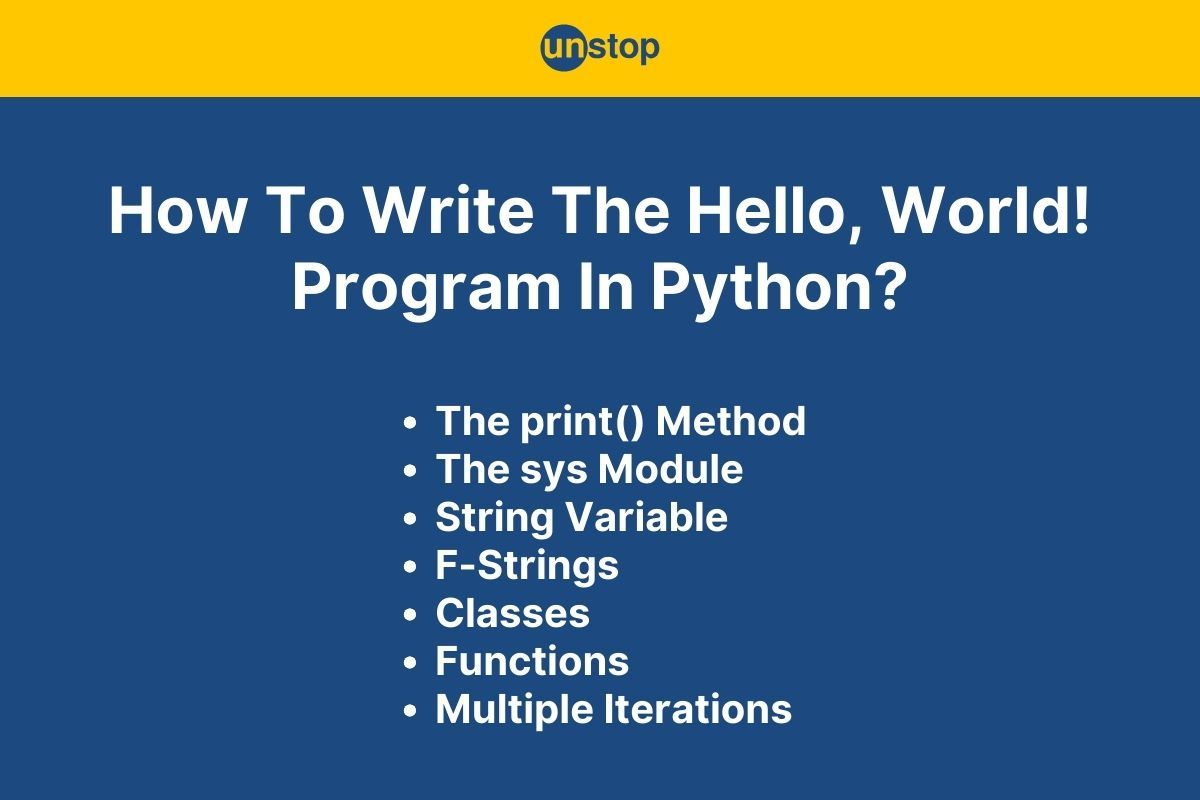
Python is a high-level, interpreted programming language. It is a popular choice among both novices and experienced developers due to its versatility and accessibility in the wide and ever-changing world of computer languages. The Hello, World program in Python is a fundamental and iconic routine that forms the foundation of each programmer's journey. So, in this article, we have set out on a quest to explain Python's Hello, World! Program and discover its importance in Python programming.
We will begin with basics about the Python language, the steps to download and set up Python, steps to create a program, and then move to discussing the various ways you can write the Hello World program.
Introduction to Python
Python is a flexible, dynamic, and adaptable programming language well-known for being easy to understand and use. Python's straightforward syntax, amazing programming structures, and extensive library and framework ecosystem have made it a leading tool in many fields, including data research, web development, and machine learning.
Having a strong hold on this language can open multiple avenues for you and help you carry out various development tasks. To begin with, you must have a strong understanding of the basics that you will be using in writing Python programs. The Hello, World program is a good starting point for beginners. In the upcoming sections, we'll break down the code of the Hello World program in Python and explore it in detail.
Downloading & Installing Python, IDLE, Tkinter, NumPy & PyGame
A Python environment must be set up with a few essential steps, which include downloading and installing Tkinter, IDLE, NumPy, and PyGame in addition to Python itself. The essential steps to get started are as follows:
Step 1: Downloading Python
- Go to the official Python website to select the downloads tab on the homepage.
- Select the most recent Python version for your operating system (Windows, macOS, or Linux), which is often Python 3.x.
- Launch the executable file after downloading the installer.
Step 2: Installing Python
- Launch the installer that you downloaded earlier.
- Make sure that, when installing Python, the ‘Add python.exe to PATH’ option is checked. This is a crucial step since it opens up Python for use from the command line.
- Comply with the installation instructions to finish the setup.
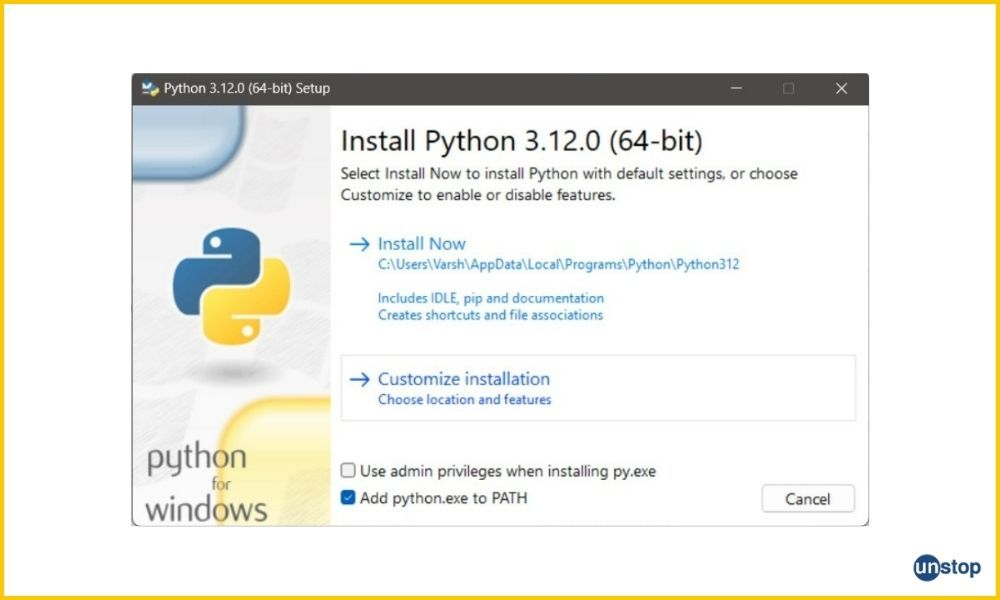
Step 3: IDLE (Integrated Development and Learning Environment)
Usually, the standard Python installation comes with IDLE. You may find it by looking for IDLE in the list of apps or programs on your computer.
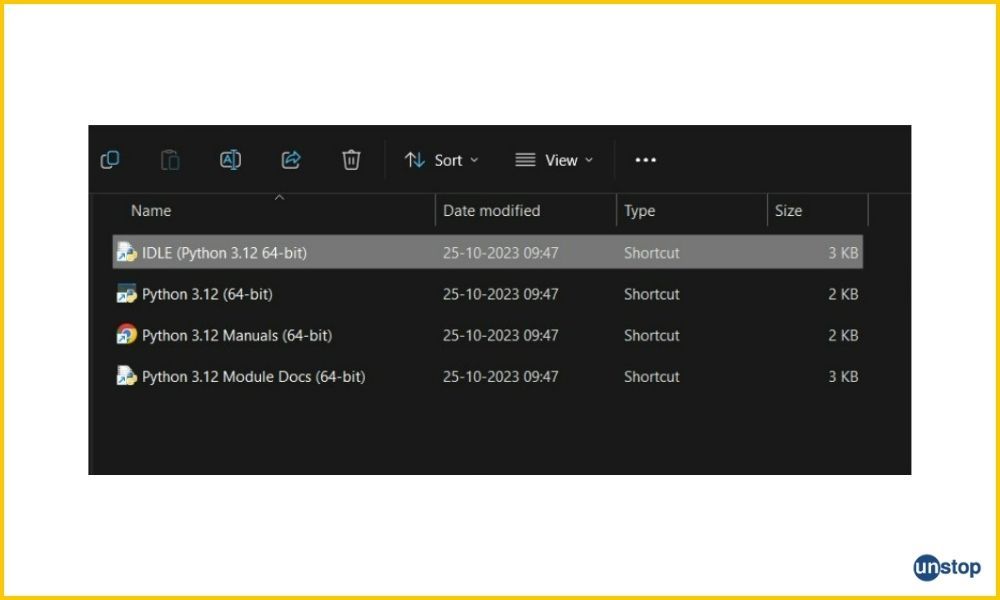
Step 4: Installing Tkinter
A Python package called Tkinter is used to create graphical user interfaces. It is typically included with Python. It doesn't require a separate installation.
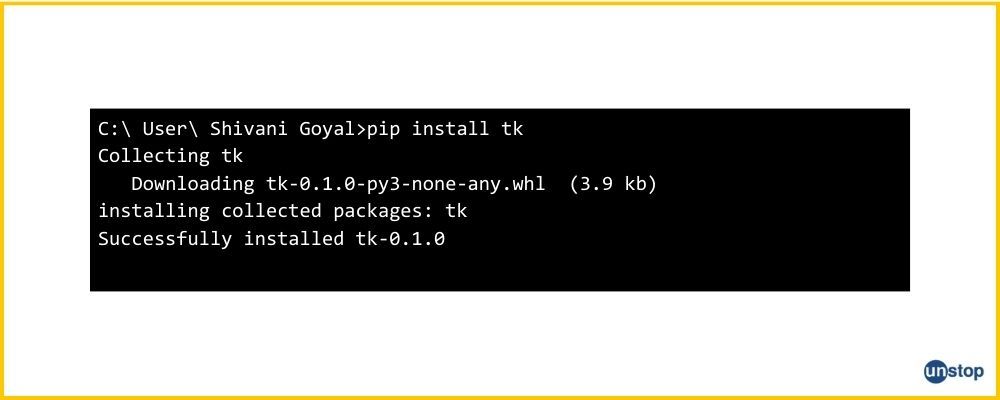
Step 5: Installing NumPy
NumPy is a well-liked Python library for numerical computations. Python usually comes with pip pre-installed, which you may use to install NumPy. Run the following command in your terminal or command prompt after opening it: pip install numpy
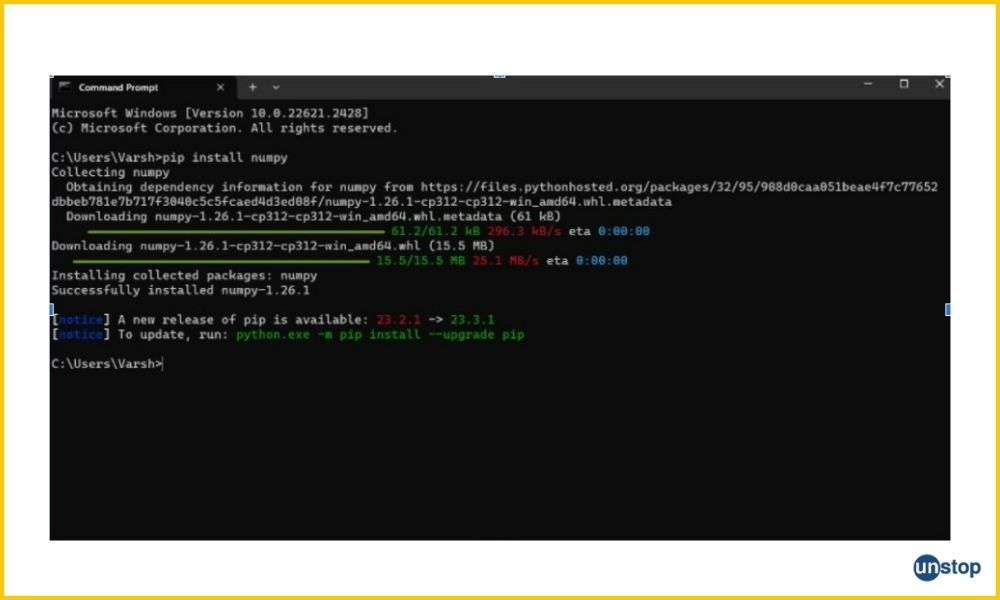
Step 6: Installing PyGame
PyGame is a Python module for making two-dimensional games, and you can use pip to install PyGame. Run the following command in your terminal or command prompt after opening it: pip install pygame
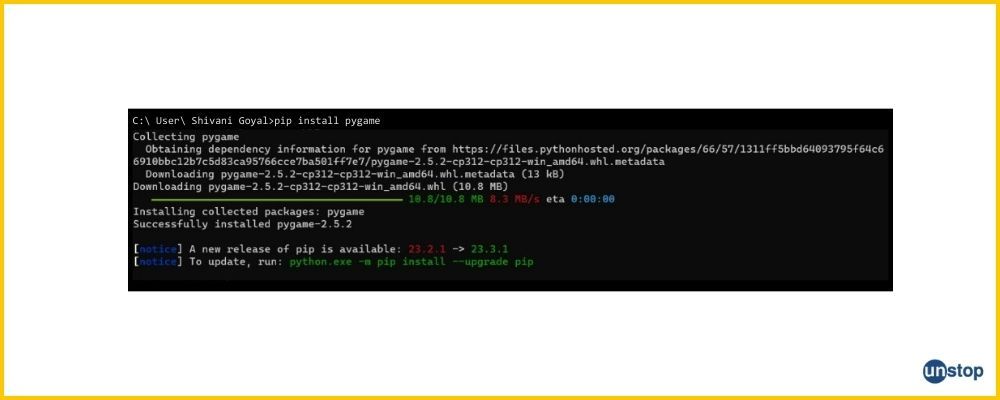
These instructions will help you get your Python programming environment up and running with all the necessary tools so you can get started writing code and creating games or apps in Python. You may use pip to install the necessary libraries if you run into any problems or need to work with more than one.
Creating A New Python Project
A new Python project can be created in a few simple steps. The same applies to the Hello World program in Python. The process to get this done is given below, along with a few screenshots.
Step 1- Create a Project Directory: First, choose or create a directory on your computer to save your Python project. Use the file explorer or terminal on your PC to accomplish this.
Step 2: Open a Text Editor or Integrated Development Environment (IDE)
- For Python, you may use a variety of text editors or integrated development runtime environments (IDEs), such PyCharm and Visual Studio Code, or simply a basic text editor like Notepad on Windows or TextEdit on macOS.
- Launch the IDE or text editor of your choice.
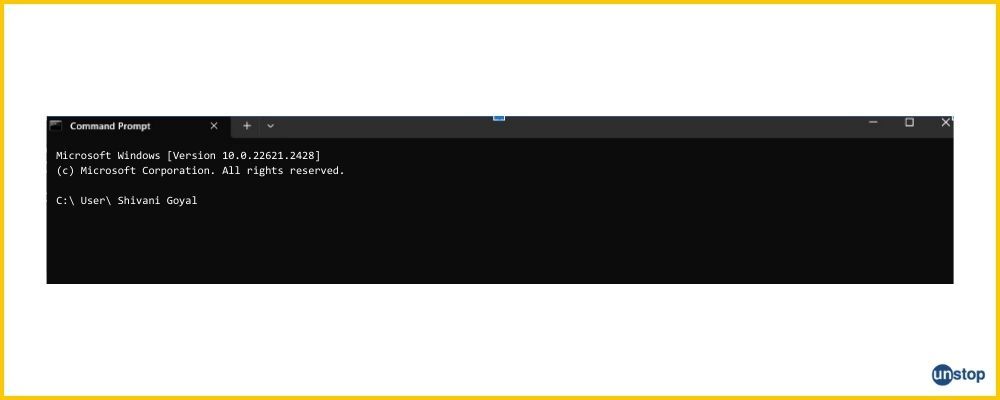
Step 3: Write the Python "Hello, World!" Code
- Make a new file in your IDE or text editor and write the code. For example, print("Hello, World!")
- Save the file in the project directory that you made, preferably with a (.py) extension, for example, hello.py.
Step 4: Launch the Python application
- Launch the terminal or command prompt on your PC.
- Make use of the cd command to go to the project directory. For instance, you may run the following command (Windows) if your ‘hello.py’ file was saved to the desktop: cd Desktop
- Use this command to run your Python application once you're in the project directory: python hello.py
Step 5- Examine the Results: Upon launching the software, "Hello, World!" ought to appear on your terminal or command prompt.
That’s it! You've successfully written and run a Python "Hello, World!" program. You may now construct even more intricate Python projects, experiment with different Python libraries, and hone your coding abilities.
How To Write Python Hello World Program In Python?
There are multiple ways in which you can create a Hello World program in Python and print the required string message on the console. We will discuss each method in upcoming sections, but first, let's take a look at the general process of developing a Python "Hello, World!" program.
Step 1- Launch an Integrated Development Environment (IDE) or text editor: Any text editor or Python integrated development environment (IDE) can be utilized, including Visual Studio Code, PyCharm, and even simple text editors like Notepad on Windows or TextEdit on macOS. Open your preferred code editor.
Step 2- Make a New File in Python: Make a new file in your coding editor. This is where your Python code should be written.
Step 3- Write the code for "Hello, World!": Type the following line of Python code into the newly generated file: print("Hello, World!").
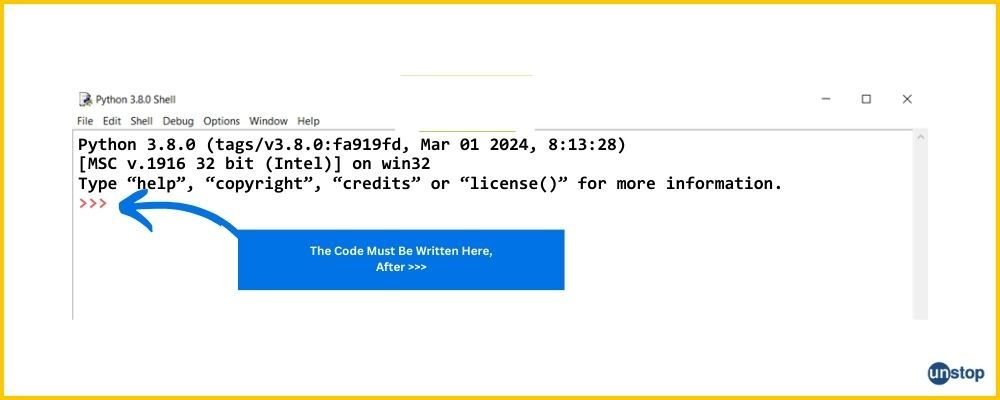
Step 4- Save the File: Use the .py extension when saving the file. One possible name for it might be hello.py.
Step 5- Run the Python program: Launch the terminal or command prompt on your PC. Then-
- Press the Windows key, input cmd, then hit Enter to launch it on Windows. Alternatively, launch the Terminal software on macOS.
- Open the directory containing your hello.py file. The cd command can be used to switch directories. For instance, if you saved the file on your desktop, you may use Windows to go to the desktop by doing the following: cd Desktop.
- Use the following command to run your Python application after you're in the right directory: python hello.py.
Step 6- Observe the Output: The program should print "Hello, World!" to the terminal or command prompt after running/ execution.
We have just finished writing and running a Python "Hello, World!" application. This simple program teaches you the basics of using the print function to show text, which makes it a great place for anybody learning Python to start. You may now experiment and create increasingly intricate Python programs.
Explanation Of Code
Let us break down the "Hello, World!" Python code into its basic components and elucidate its operation:
- Import Statement (Not Present): Since we're not utilizing any external libraries, our code has no import lines.
- The print() Function: We use the built-in Python method print() to show text or other objects on the terminal. For example, to display the string- Hello, World!, we use syntax- print("Hello, World!").
- The String: Because "Hello, World!" is surrounded by double quotes, Python treats it as a string. That is, the text is represented by strings, which are a sequence of characters.
- Flow of Execution: The Python interpreter reads the whole Python program from start to finish when it is executed. When it comes across the print("Hello, World!") line, it runs it.
- Output: Python is told to emit Hello, World! to the terminal by the print("Hello, World!") command.
To sum up, the program is really simple. It prints "Hello, World!" to the terminal using the print() method. This is a basic illustration of how to generate output in Python. Comprehending this fundamental technique is crucial when advancing to increasingly intricate Python programming assignments.
Way To Write The Hello, World! Program In Python
One of Python's most popular beginning exercises is to print "Hello, World!" to begin learning the language. It's an easy method to make if you can run basic code and your Python programming environment is configured appropriately. In Python, there are several ways to print "Hello, World!" This includes utilizing f-strings, the sys module, a string variable, and the print() function. Let's look at each of these alternative approaches one by one.
The Hello, World! Program In Python Using Print()
The print() function is a built-in function used to display information on the console. It takes one or more arguments, which can be strings, variables, or complex expressions, and outputs them to the standard output (usually the console). It's quite simple to print Hello, World! in Python by utilizing the print() method.
Code Example:
# Hello, World using print() function
print("Hello, World!")
Output:
Hello, World!
Explanation:
In the Python code example-
- We begin by including the print() function, a built-in Python function that displays output on the console or output screen.
- Inside the parentheses of the print() function, we include a string with double quotes, i.e., "Hello, World!".
- When the code is executed, the print() function will output the string "Hello, World!" to the console.
The Hello, World! Program In Python Using Sys Module
The sys module in Python provides us access to multiple variables maintained/ used by the Python interpreter. And multiple functions that help interact with and manipulate different sections of the Python program runtime environment. We can use the sys module to write the Hello World program in Python with the Command-line arguments feature. In the example below, we print the message using the sys.stdout.write() function.
Code Example:
CODE SNIPPET IS HEREI2ltcG9ydGluZyB0aGUgc3lzIG1vZHVsZQ0KaW1wb3J0IHN5cw0KDQojQ29tbWFuZCB0byBwcmludCBIZWxsbywgV29ybGQgdG8gdGhlIGNvbnNvbGUNCnN5cy5zdGRvdXQud3JpdGUoIkhlbGxvLCBXb3JsZCFcbiIp
Output:
Hello, World!
Explanation:
In the sample Python program-
- We begin by including/ importing the sys module, i.e., import sys statement.
- The import keyword is used to bring a module (in this case, sys) into the current Python script, making its functions and features available for use.
- We then use the write() function/ method from the module to write the string "Hello, World!\n" to the standard output. That is, use sys.stdout.write(), where sys.stdout refers to the standard output stream.
- We also use the newline character, causing a line break (the cursor moves to the next line) after printing the message.
The Hello, World! Program In Python Using String Variable
You may use a string variable to write the Hello World program in Python. The process is extremely straightforward; where we first declare a string variable and then print it to the console. Using a string variable can make the code more flexible and manageable since you can simply alter the message you wish to print by changing the contents of the message variable.
Code Example:
CODE SNIPPET IS HEREI0RlY2xhcmluZyBhIHN0cmluZyB2YXJpYWJsZSBhbmQgaW5pdGlhbGl6aW5nIGl0DQpoZWxsb19tZXNzYWdlID0gIkhlbGxvLCBXb3JsZCEiDQoNCiNQcmludGluZyB0aGUgbWVzc2FnZSB1c2luZyB0aGUgcHJpbnQoKSBtZXRob2QNCnByaW50KGhlbGxvX21lc3NhZ2Up
Output:
Hello, World!
Explanation:
In the sample Python code-
- We first declare a variable hello_message and assign the string value "Hello, World!" to it using double quotes.
- After the variable is assigned, we use the print() function to display the content of the variable on the console.
- This code demonstrates the use of variables to store and manage data, making the code more flexible and readable.
The Hello, World! Program In Python Using F-String
You can use an f-string to write a Python program that prints "Hello, world!".The f-string allows us to embed/ insert variables and expressions straight into strings, making it a concise and readable way to include variables in the output. In other words, the f-string offers a clear and comprehensible method of formatting output.
Code Example:
message = "Hello, World!"
print(f"{message}")
Output:
Hello, World!
Explanation:
In the above Python code-
- We assign the message variable with the string value "Hello, World!".
- Then, we use the print() function with an f-string to display the content of the variable on the console.
- The f-string is created by prefixing the string with the letter f and enclosing the variable name within curly braces: f"{message}".
The output of "Hello, World!" to the console is the same for all of these approaches. The approach you use will rely on your coding style and particular needs. The most popular and simple method for displaying text in Python is to use the print() function.
The Hello, World! Program In Python Using Class
A class in Python is an object creation blueprint or template. It specifies a collection of methods (functions) and properties (variables) that the objects made from the class will possess. Real-world entities are modeled using classes, which combine their data and behavior into a unified entity. As instances of a class, objects can share the methods described in the class but also have their own distinct data.
Code Example:
CODE SNIPPET IS HEREIyBEZWZpbmUgYSBjbGFzcyBuYW1lZCBIZWxsb1dvcmxkUHJpbnRlcg0KY2xhc3MgSGVsbG9Xb3JsZFByaW50ZXI6DQoNCiMgQ29uc3RydWN0b3IgbWV0aG9kIGNhbGxlZCB3aGVuIGFuIGluc3RhbmNlIGlzIGNyZWF0ZWQNCmRlZiBfX2luaXRfXyhzZWxmKToNCiMgQXNzaWduIHRoZSBzdHJpbmcgIkhlbGxvLCBXb3JsZCEiIHRvIHRoZSBpbnN0YW5jZSB2YXJpYWJsZSBzZWxmLm1lc3NhZ2UNCnNlbGYubWVzc2FnZSA9ICJIZWxsbywgV29ybGQhIg0KDQojIE1ldGhvZCB0byBwcmludCB0aGUgc3RvcmVkIG1lc3NhZ2UNCmRlZiBwcmludF9tZXNzYWdlKHNlbGYpOg0KIyBQcmludCB0aGUgdmFsdWUgb2YgdGhlIGluc3RhbmNlIHZhcmlhYmxlIHNlbGYubWVzc2FnZQ0KcHJpbnQoc2VsZi5tZXNzYWdlKQ0KDQojIENyZWF0ZSBhbiBpbnN0YW5jZSBvZiB0aGUgSGVsbG9Xb3JsZFByaW50ZXIgY2xhc3MNCmhlbGxvX3ByaW50ZXIgPSBIZWxsb1dvcmxkUHJpbnRlcigpDQoNCiMgQ2FsbCB0aGUgcHJpbnRfbWVzc2FnZSBtZXRob2Qgb24gdGhlIGluc3RhbmNlDQpoZWxsb19wcmludGVyLnByaW50X21lc3NhZ2UoKQ==
Output:
Hello, World!
Explanation:
In this Python code,
- Firstly, we define a class named HelloWorldPrinter. This class encapsulates functionality related to printing a specific message.
- The class has two methods, i.e., a constructor method (__init__) and a method to print the stored message (print_message).
- The __init__ method is a special method that gets called when an instance of the class is created. Within this method, we initialize an instance variable self.message with the string "Hello, World!".
- The print_message method is responsible for printing the value stored in the self.message variable to the console using the print function.
- After defining the class, we create an instance of HelloWorldPrinter that is assigned to the variable hello_printer.
- Then, we call the print_message method on the instance, which prints the message Hello, World! to the console.
This code shows how to write the Hello World program in Python by encapsulating the printing functionality within a class. You may make instances of the HelloWorldPrinter class, each with a unique message, and use the print_message function to see the message.
The Hello, World! Program In Python Using Function
You may write a function in Python to encapsulate a particular job or collection of instructions. This function can accept a few inputs, sometimes referred to as arguments or parameters, and return a value. To show how to write a Hello World program in Python using functions, we will construct a basic function and then call it to print the message to the console.
Code Example:
CODE SNIPPET IS HEREI0RlZmluaW5nIGEgZnVuY3Rpb24gdGhhdCBwcmludHMgYSBtZXNzYWdlIHRvIHRoZSBjb25zb2xlDQpkZWYgcHJpbnRfaGVsbG9fd29ybGQoKToNCmdyZWV0aW5nID0gIkhlbGxvLCBXb3JsZCEiDQpwcmludChncmVldGluZykNCg0KIyBDYWxsaW5nIHRoZSBmdW5jdGlvbiB0byBwcmludCBIZWxsbywgV29ybGQhDQpwcmludF9oZWxsb193b3JsZCgp
Output:
Hello, World!
Explanation:
- We begin the code by defining a function called print_hello_world.
- Inside this function, we declare a local variable named greeting and assign the string- Hello, World!, to it. This variable serves as a container for the greeting message.
- We also include the print() function, which then displays the content of the greeting variable.
- Following the function definition, we proceed to call the print_hello_world function.
- As a result, the function body is executed, and the message "Hello, World!" is printed to the console.
Using functions makes it easier to reuse a section of code and perform tasks (here, printing Hello World) anytime and any number of times. This is a basic example, and functions can be used to carry out a variety of intricate tasks.
Print Hello World 5 Times Using A For Loop
A loop is a construct that helps automate a repeated process, such as writing "Hello, World!" several times. For example, we can use a for loop to continually run a piece of code and iterate over a sequence (such as a range of integers). Below is an example of Python code that prints "Hello, World!" five times using a for loop:
Code Example:
for _ in range(5):
print("Hello, World!")
Output:
Hello, World!
Hello, World!
Hello, World!
Hello, World!
Hello, World!
Explanation:
In this Python code-
- We begin by setting up a for loop, i.e., for _ in range(5).
- The range(5) function generates a sequence of numbers from 0 to 4, and the loop iterates over each number in this sequence.
- Within the loop body, we have the print() function, with the string message- "Hello, World!". This function prints the enclosed message to the console when called.
- When this program is executed, the statement inside the loop is executed five times, i.e., it prints Hello, World! to the console 5 times.
Conclusion
The Hello, World! Program in Python is a basic step when it comes to learning this language. This program explains the fundamental concepts and techniques of programming in Python. We can write the Hello World program in multiple ways to display the message. The most basic and commonly used method is the use of the print() function.
Other methods include using the write() method from the sys module, string variable, f-strings, classes, functions, and loops. Learning how to write this basic program will help you comprehend the fundamental grammar of Python programming. It introduces variables, functions, and control flow, laying a strong foundation for more difficult programming tasks.
Frequently Asked Questions
Q. How to print Hello, World in the loop?
In a programming language like Python, you can use a basic for loop or while loop to print the string- Hello, World repeatedly. Here's an illustration utilizing both kinds of loops:
Using a for loop:
for i in range(5): # This will print "Hello, World" 5 times
print("Hello, World")
Using a while loop:
count = 0
while count < 5: # This will print "Hello, World" 5 times
print("Hello, World")
count += 1
Both the code snippets above will print the message- Hello, World! five times. You can also adjust the while loop's condition or the number in the range to modify the number of prints.
Q. What are the 4 types of functions?
Based on how they behave and are used, functions in mathematics and computer programming may be divided into four primary categories:
- Built-in Functions (Library Functions): These are those functions that are pre-installed in programming languages and are easily accessible. They carry out routine processes and activities, including input/output, string manipulation, and mathematical computations. In Python, print() and len() are two examples.
- User-defined Functions: The functions are defined by users/ programmers to package a collection of instructions into a reusable block of code. Code is more readable and manageable when it is organized and modularized with the use of user-defined functions.
- Recursive Functions: When user-defined functions repetitively call themselves within their own bodies, they are known as recursive functions. They are frequently employed in the resolution of issues that may be divided into more manageable, related sub-issues. A well-known example is the recursive factorial computation, factorial(n) = n * factorial(n-1).
- Anonymous Functions (Lambda Functions): Functions without a name are sometimes known as anonymous functions. They are usually defined on the fly and used for brief, straightforward activities. Lambda functions are frequently used alongside methods like map(), filter(), and reduce() for efficient data processing. They are widely available in programming languages such as Python.
These four categories of functions encompass a broad spectrum of programming capabilities, enabling programmers to carry out a variety of tasks and produce organized, effective code.
Q. How to print Hello World 100 times in Python?
In Python, you can utilize a for loop to iterate and print the message- Hello, World! 100 times. This method is similar to printing the same for 5 times. Here's how to accomplish it:
for i in range(100):
print("Hello, World")
This code prints the message- Hello, World! to the console on each iteration. Since the range is 100, this code, when executed will prints the variable message 100 times. The loop runs from 0 to 99 times.
Q. How to define a function in Python?
In Python, we must use the def keyword along with the function name, parameter names inside parentheses, and a colon to define a function. The code block for the function is nested behind the def declaration. The basic syntax for creating a function in Python is as follows:
def function_name(parameters):
# Function code goes here
# Indented code block
# ...
An explanation of each part is provided below:
- def: The keyword def informs Python that a function is being defined.
- function_name: Refers to the name you have given to the function.
- Parameters: These are the list of input parameters (also called arguments) that the function requires for execution. They are mentioned inside of the parenthesis, and there can be more than one parameter, separated by commas. Even in the case when the function accepts no input, empty parenthesis, such as (), are still required.
- Function code: The function's body is the indented chunk of code that appears after the def statement. This is where the function's functionality is defined. It may include computations, statements, and further Python code.
The following is a basic illustration of a function that adds two numbers:
def add_numbers(a, b):
result = a + b
return result
The function name in this example is add_numbers, and its two parameters are a and b. The function uses the return statement to return the result after adding together the values of a and b. This function can be called as follows in other places in your code:
result = add_numbers(5, 3)
print(result) # This will print 8
Thus, this is how a function can be defined in Python.
Q. How to print Hello, World without the main function?
We can write a Hello World program in Python without a main function or any function with the name main. This is because Python code does not require a main function in order to be performed immediately. You can include the following line of code in your script to print the message Hello, World! directly:
print("Hello, World")
This shows, that unlike several other programming languages, Python does not require a main function.
Q. What is a string code?
In computer programming, a string code is usually defined as a series of letters or symbols that represent text. Textual data is frequently stored and managed using strings. In computer languages, they are often denoted by single or double quotation marks to differentiate them from other kinds of data. For example,
my_string = "Hello, World!"
Here, the string literal "Hello, World!" is assigned to the variable my_string. We can then work with and manipulate this string in many ways, including string operations, concatenation, and character extraction.
Some typical string operations are as follows:
- Concatenation: The process of joining two or more strings.
string1 = "Hello, "
string2 = "World!"
result = string1 + string2 # result will be "Hello, World!"
- Substring: Extracting a portion of a string.
my_string = "Hello, World!"
substring = my_string[7:12] # substring will be "World"
- Length: Determining a string's length, or total character count.
my_string = "Hello, World!"
length = len(my_string) # length will be 13
To do particular operations on strings, for instance, you may use the split(), strip(), replace(), and several other string methods in Python. Here's an illustration of how to use the string method:
my_string = " Some spaces in the beginning and end. "
trimmed_string = my_string.strip() # Removes leading and trailing spaces
Depending on the computer language you're using, there are other methods to represent and work with string codes. Still, the basic idea of a string as a collection of special characters never changes.
Q. What is an example of a function in Python ?
In Python, a function is a block of code that carries out one or more specified tasks. The function definition generally consists of the function name, the def keyword, two parentheses for optional parameters, and a colon. Below is an example of a function definition and use in Python.
Code Example:
CODE SNIPPET IS HEREI0RlZmluaW5nIGEgZnVuY3Rpb24gdGhhdCBwcmludHMgYSBtZXNzYWdlIHRvIHRoZSBjb25zb2xlDQpkZWYgcHJpbnRfaGVsbG9fd29ybGQoKToNCiAgZ3JlZXRpbmcgPSAiSGVsbG8sIFdvcmxkISINCiAgcHJpbnQoZ3JlZXRpbmcpDQoNCiMgQ2FsbGluZyB0aGUgZnVuY3Rpb24gdG8gcHJpbnQgSGVsbG8sIFdvcmxkIQ0KcHJpbnRfaGVsbG9fd29ybGQoKQ==
In this example, we have created a welcome function, which accepts a single input called name. The function will output- Hello, Alice!, to the console when you call it with greet("Alice"). The components of the function are as follows:
- def greet(name): This is the function's definition, i.s., it has the name greet and a name argument.
- """This function greets the person passed in as a parameter.""": This is a docstring that gives a quick overview of the function's capabilities. Although it's unnecessary, adding it for documentation's sake is a good idea.
- print(f"Hello, {name}!"): The function body begins with this print statement, where an f-string is used to print a greeting message along with the supplied name.
- greet("Alice"): This is how we call the greet() function by passing the value Alice as the name parameter to invoke the greet function.
Python functions may be far more sophisticated and used for a wide range of activities, such as data processing, file operations, computations, and more. They are an essential Python building piece that helps with efficient code organization and reuse.
👋 Python's 'Hello, World!'—How Well Do You Know It?
By now, you must know how to write Hello, World! program in not one but 7 ways. Here are a few other articles you must read:
- How To Reverse A String In Python? 10 Easy Ways With Examples!
- 10 Important Features Of Python That You Must Know!
- Relational Operators In Python | 6 Types, Usage, Examples & More!
- 12 Ways To Compare Strings In Python Explained (With Examples)
- Python Logical Operators, Short-Circuiting & More (With Examples)
- Python Bitwise Operators | Positive & Negative Numbers (+Examples)
An economics graduate with a passion for storytelling, I thrive on crafting content that blends creativity with technical insight. At Unstop, I create in-depth, SEO-driven content that simplifies complex tech topics and covers a wide array of subjects, all designed to inform, engage, and inspire our readers. My goal is to empower others to truly #BeUnstoppable through content that resonates. When I’m not writing, you’ll find me immersed in art, food, or lost in a good book—constantly drawing inspiration from the world around me.
Login to continue reading
And access exclusive content, personalized recommendations, and career-boosting opportunities.
Subscribe
to our newsletter
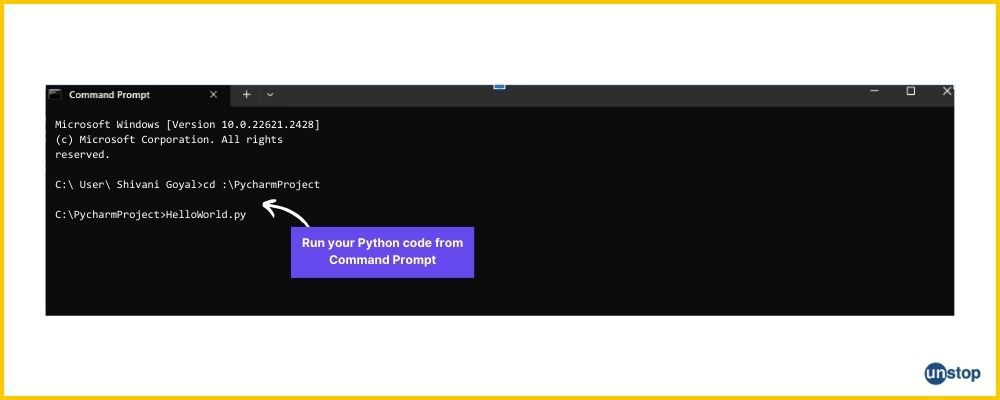















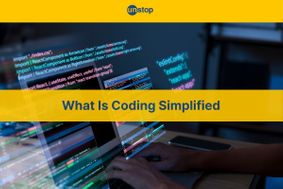
Comments
Add comment